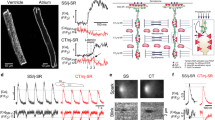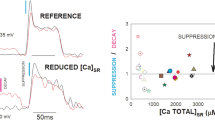Abstract
We have investigated the links between electrical excitation and contraction in mammalian heart muscle. Using isolated single cells from adult rat ventricle, a whole-cell voltage-clamp technique and quantitative fluorescence microscopy, we have measured simultaneously calcium current (Ica) and [Ca2+]i (with fura-2). We find that the voltage-dependence of Ica and the [Ca 2+]i-transient and the dependence of [Ca2+]i-transient on depolarization-duration cannot both be readily explained by a simple calcium-induced Ca-release (‘CICR’) mechanism. Additionally, we find that when [Ca2+]i and [Na+]i are at their diastolic levels, activation of the Na-Ca exchange mechanism by depolarization does not measurably trigger the release of Ca2+i. Finally, measuring Ica in adult and neonatal rat heart cells and using the alkaloid ryanodine, we have carried out complementary experiments. These experiments show that there may be an action of ryanodine on Ica that is independent of [Ca2+]i and independent of a direct action of the alkaloid on the calcium channel itself. Along with experiments of others showing that ryanodine binds to the sarcoplasmic reticulum calcium-release channel/spanning protein complex, our data suggests a model to explain our findings. The model links the calcium channels responsible for Ica to the sarcoplasmic reticulum by means of one or more of the spanning protein(s). Information from the calcium channel can be communitated to the sarcoplasmic reticulum by this route and, presumably, information can move in the opposite direction from the sarcoplasmic reticulum to the calcium channel.
Similar content being viewed by others
References
Fabiato A: Stimulated calcium current can both cause calcium loading in and trigger calcium release from the sarcoplasmic reticulum of a skinned canine cardiac Purkinje cell. J Gen Physiol 85: 291–320, 1985
Cannell MB, Berlin JR, Lederer WJ: Effect of membrane potential changes on the calcium transient in single rat cardiac muscle cells. Science 238: 1419–1423, 1987
Cohen NM, Lederer WJ: Calcium current in isolated neonatal rat ventricular myocytes. J Physiol 391: 169–191, 1987
Schneider MF, Chandler WK: Voltage-dependent charge movement in skeletal muscle: a possible step in excitationcontraction coupling. Nature 242: 244–246, 1973
Imagawa T, Smith JS, Coronado R, Champbell KP: Purified ryanodine receptor from skeletal muscle sarcoplasmic reticulum is the Ca2+-permeable pore of the calcium release channel. J Biol Chem 262: 16636–16643, 1987
Inui M, Saito A, Fleischer S: Isolation of the ryanodine receptor from cardiac sarcoplasmic reticulum and identity with the feet structures. J Biol Chem 262: 15637–15642, 1987
Bean BP, Rios E: Asymmetric charge movement in mammalian cardiac muscle cells: Na and Ca channel components. Biophysical J 53: 158 (abstract), 1988
Hadley RW, Lederer WJ: Description of charge movement in isolated guinea-pig and rat ventricular myocytes. Biophysical J. In Press (abstract), 1989
Cohen NM, Lederer WJ: Changes in the calcium current of rat heart ventricular myocytes during development. J Physiol 406: 115–146, 1988
Author information
Authors and Affiliations
Rights and permissions
About this article
Cite this article
Lederer, W.J., Cannell, M.B., Cohen, N.M. et al. Excitation-contraction coupling in heart muscle. Mol Cell Biochem 89, 115–119 (1989). https://doi.org/10.1007/BF00220762
Accepted:
Issue Date:
DOI: https://doi.org/10.1007/BF00220762




